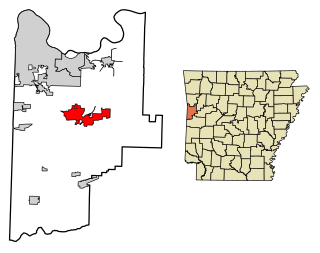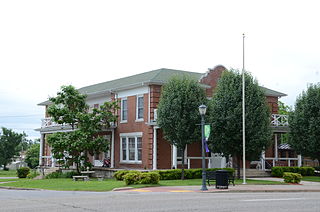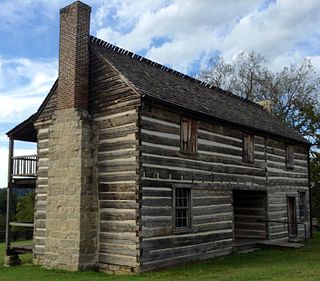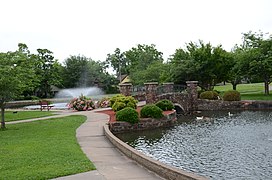
Mena is a city in Polk County, Arkansas, United States. It is also the county seat of Polk County. The population was 5,558 as of the 2020 census. Mena is included in the Ark-La-Tex socio-economic region. Surrounded by the Ouachita National Forest, Mena is a gateway to some of the most visited tourist attractions in Arkansas.

Greenwood is a city in and one of the two county seats of Sebastian County, Arkansas, United States. It is the fifth largest municipality in the Fort Smith, Arkansas-Oklahoma Metropolitan Statistical Area with a population of 8,952 according to the 2010 US Census. According to estimates based on the most recent census, the population of Greenwood in 2018 was 9,397.

Petit Jean State Park is a 3,471-acre (1,405 ha) park in Conway County, Arkansas managed by the Arkansas Department of Parks and Tourism. It is located atop Petit Jean Mountain adjacent to the Arkansas River in the area between the Ouachita Mountains and Ozark Plateaus.

Located near Dardanelle, Arkansas and rising about 1,350 feet (410 m) above the mountain valleys of west-central Arkansas to an elevation of about 1,755 feet (535 m) above sea level, Mount Nebo has views of 34,000 acres (140 km2) Lake Dardanelle, the Arkansas River and the surrounding mountain ridges. Atop this biblically named plateau is Mount Nebo State Park. Developed as a resort area in the late 19th century, it became a state park in 1928, its early development spearheaded by the Civilian Conservation Corps. Park activities include hiking, camping, and other outdoor pursuits.

Highway 8 is an east–west state highway in Lower Arkansas. The route of 229.83 miles (369.88 km) runs from Oklahoma State Highway 63 (SH-63) at the Oklahoma state line east across the state to US Route 65 (US 65) south of Eudora.

The National Guard Armory is a history armory building at DeQueen and Maple Streets in Mena, Arkansas. It is a large single-story Art Deco building, fashioned out of fieldstone and concrete in 1931. It is the best example in Mena of a stone building style more typically found in the more mountainous surrounding areas. It was designed by Derwood F. Kyle of Pine Bluff, and was from the start designed to include community meeting spaces, a function the building continues to perform.

The Elks Lodge is a historic clubhouse at 500 Mena Street in Mena, Arkansas. It is a two-story brick building, with a hip roof, marble trim, and a granite foundation. Its Colonial Revival styling includes corner quoining, porches along the front and side with square supporting posts and diamond-pattern balcony balustrade above. It was built in 1908 by the local chapter of the Elks fraternal organization, and has long been a local social venue. Between 1935 and 1951 it housed the local hospital, after which it returned to the Elks. It is also one of the community's finest examples of commercial Colonial Revival architecture.

U.S. Highway 71 is a U.S. highway that runs from Krotz Springs, LA to the Fort Frances–International Falls International Bridge at the Canadian border. In Arkansas, the highway runs from the Louisiana state line near Doddridge to the Missouri state line near Bella Vista. In Texarkana, the highway runs along State Line Avenue with US 59 and partially runs in Texas. Other areas served by the highway include Fort Smith and Northwest Arkansas.
The SS Homer was a sidewheel paddle steamer which plied the waters of the Mississippi River and its tributaries. Built in 1859 in Parkersburg, West Virginia, she was 148 feet (45 m) long, 28 feet (8.5 m) wide, and 5 feet (1.5 m) deep. Her first significant service was in 1860, when she was used as a packet steamer on the Red and Ouachita Rivers, under master and co-owner Samuel Applegate. In 1861, after the start of the American Civil War, she was contracted to the government of the Confederate States of America, and was used to transport men and war materiel. She was used to supply the defenders of Port Hudson, Louisiana, in 1864. That year she was captured by the Union Army forces of General Frederick Steele when she was about 30 miles (48 km) below Camden, Arkansas on the Ouachita River. Steele was at the time engaged in a major expedition whose goal was to reach Shreveport, Louisiana, but had stalled due to Confederate resistance and a lack of supplies. Steele had then occupied Camden, and it was during this occupation that the ship was taken, loaded with grain and other supplies. The Union forces piloted her back to Camden.

The Jacob Wolf House is a historic house on Arkansas Highway 5 in Norfork, Arkansas. It is a log structure, built in 1825 by Jacob Wolf, the first documented white settler of the area. Architecturally it's a "saddle bag", which is a two-story dog trot with the second floor built over the open breezeway. A two-story porch extends on one facade, with an outside stair giving access to the upper floor rooms. The building's original chinking has been replaced by modern mortaring. It is maintained by the Department of Arkansas Heritage as a historic house museum.

Lake Leatherwood Park is a municipal park on the north side of Eureka Springs, Arkansas. The park covers 1,600 acres (650 ha), and its centerpiece is Lake Leatherwood, a 100-acre (40 ha) body of water created by the Lake Leatherwood Dam, which impounds West Leatherwood Creek. The dam, along with roadways, recreational facilities, and other elements of the park, were built in the 1930s by work crews of the Civilian Conservation Corps (CCC) with funding from the federal government's Soil Conservation Service.

The Simon Sager Cabin is a historic log cabin on the campus of John Brown University in Siloam Springs, Arkansas. Built in the 1830s, it is believed to be the very first homestead cabin built in northwestern Arkansas. It is a single-story structure fashioned out of hand-hewn logs that have been squared and chamfered, and joined by notches, with the gaps filled by limestone chinking. It originally was located downtown near the present-day city park, but was relocated to the John Brown University campus.

The Mena Commercial Historic District encompasses the historic downtown area of Mena, Arkansas, the county seat of Polk County in western Arkansas. The district extends along Mena Street between Port Arthur and Gillham Avenues, extending a short way to the south on Sherwood Avenue, opposite the railroad tracks for which the town's existence is responsible. Mena was founded as a major railroad service town for the Kansas City, Pittsburg and Gulf Railroad, as its site was located midway between Port Arthur, Texas and Kansas City, Missouri. The railroad located a major service yard here, and the town grew up around it. Most of its commercial center was developed between 1896 and 1940, with a variety of one and two-story commercial brick buildings in typical early 20th-century styles. The district, listed on the National Register of Historic Places in 2009, includes four properties previously listed separately: the railroad station, Mena City Hall, the former Elks Lodge, and the former Studebaker Showroom.

The Mena Kansas City-Southern Depot is a historic railroad station on Sherwood Street in the center of Mena, Arkansas. It is long single-story structure, built out of brick, with a tile roof and Mediterranean styling. It was built in 1920 by the Kansas City Southern Railway to designs by the company architect, T. C. Horstmann, and is one of the most elaborate surviving early-20th century railroad stations in the state. It is now owned by the city, and houses a local history museum and the local chamber of commerce.

Mena City Hall, also known as the Old Post Office, is the city hall of Mena, Arkansas, located at 520 North Mena Street. It is a two-story brick building with Classical Revival and Colonial Revival features, designed by Treasury architect James Wetmore and built in 1917. Its elaborate lobby decorations are still visible despite the building's conversion for use as city hall. Its exterior features a Classical pedimented portico, and an entrance topped by a Colonial Revival fanlight.

The Polk County Courthouse is a historic government building at Church Avenue and DeQueen Streets in Mena, Arkansas, the county seat of Polk County. The original portion of the building is a two-story light-colored brick structure, with restrained Art Deco styling. It was designed by Haralson and Mott of Fort Smith, and was built in 1939 with funding from the Public Works Administration. To the rear of the courthouse is a modern wing, joined by a breezeway. The original building is little-altered—only its front doors have been replaced with modern glass and aluminum doors.

St. Agnes Catholic Church is a Roman Catholic church at 203 Eighth Street in Mena, Arkansas. The parish, established not long after Mena's founding in 1896, meets in a stone Spanish Mission Revival built in 1921–22 to a design by Rev. A. P. Gallagher, who oversaw the parish for more than 50 years. It is one of Polk County's most significant architectural statements, merging the common use of local fieldstone with more sophistical Mission style elements. The church was listed on the National Register of Historic Places in 1991.

The Judge Benjamin Shaver House is a historic house at 701 12th Street in Mena, Arkansas. It is a 2+1⁄2-story wood-frame structure, with a hip roof that projects over a two-story porch. There are further stepped projectings beyond this, culminating in an gable section supported by Ionic columns, with a Palladian window in the pedimented gable end. The house was built in 1896, two years after Mena was incorporated by Benjamin Shaver, a prominent local lawyer and judge. The building is further notable for its association with his daughter Dorothy, who parlayed an early career as a dollmaker into becoming CEO of Lord & Taylor.

The State Line Marker is a historic boundary marker on the state line between Arkansas and Oklahoma. It is located down a path a short way north of a parking area on Talimena Scenic Drive in Ouachita National Forest, about 17 miles (27 km) northwest of Mena, Arkansas. The marker was originally an octagonal cast iron pipe, with the legend "48 M" on the north face, "1877" on the south side, "ARK" on the east side, and "CHOC" on the west side. The pipe was mounted in a stone and mortar base installed by the United States Forest Service in 1974. The marker was placed in 1877 following a series of controversial surveys to demarcate the border between Arkansas and what was then Indian Territory.

The Lake Catherine State Park CCC Cabins are a collection of four rustic cabins constructed by crews of the Civilian Conservation Corps in what is now Lake Catherine State Park in Hot Spring County, Arkansas. Three of the four cabins were built for use as tourist accommodations and continue to serve in that role, while the fourth, probably built to house administrative functions, is now used in the state park as a "nature cabin", with exhibits on the history and natural environment of the park. Three of the cabins were separately listed on the National Register of Historic Places in 1992; the fourth was listed in 1995.























